
“Bronco John” Harrington Sullivan was a cowboy and showman known for his tall tales. He performed at the Oak Point Pleasure Grounds in the Bronx in 1886.
What happens when an Indiana bear, a Harlem goat, a large crowd of people, and a Wild West cowboy with a silver-plated revolver all come together at a beer garden on the beach?
Yes, the following story is from my file called “You Can’t Make This Stuff Up.”
On January 8, 1886, two Harlem men set out to buy a goat. Not just any goat, but a goat that was tough enough to fight a large black bear in “Bronco John” Harrington Sullivan’s traveling Wild West show at the Oak Point Pleasure Grounds near Hunts Point in the Bronx.
After scouring the many vacant lots in Harlem without success, the men finally found what they were looking for on East 124th Street, in the stable of the Widow O’Toole. Mrs. O’Toole was rather reluctant to part with her goat, which was a family relic and a favorite among her children and neighbors.
“Phat wud yez be wantin’ for to buy a goat at this time o’ the year for, maybe? She asked the men. “Oh, we want him to fight a bear,” one man replied. “Fight phwat? A bear? And what kind of bear? Mrs. O’Toole asked. “A black bear! Bronco John’s bear, from Wyoming,” the men told her.
Sensing that Mrs. O’Toole did not want to sell her goat, the men told her to forget about their offer. They told her they would go back to Mrs. O’Flaherty on 127th Street, whom they said had a goat “that could punish anything in Harlem.” That got Mrs. O’Toole’s goat.
“Hold on, young man,” she said. “If there’s any goat in Harlem that’s got a reppytashun to sustain it’s this goat. Take him, an’ if he don’t uphold the pride of his race let him be killed, bad luck to him.” With those words, the men paid for the goat and led him to Charles Sulzer’s Oak Point Pleasure Grounds on the East River at the foot of East 149th Street.
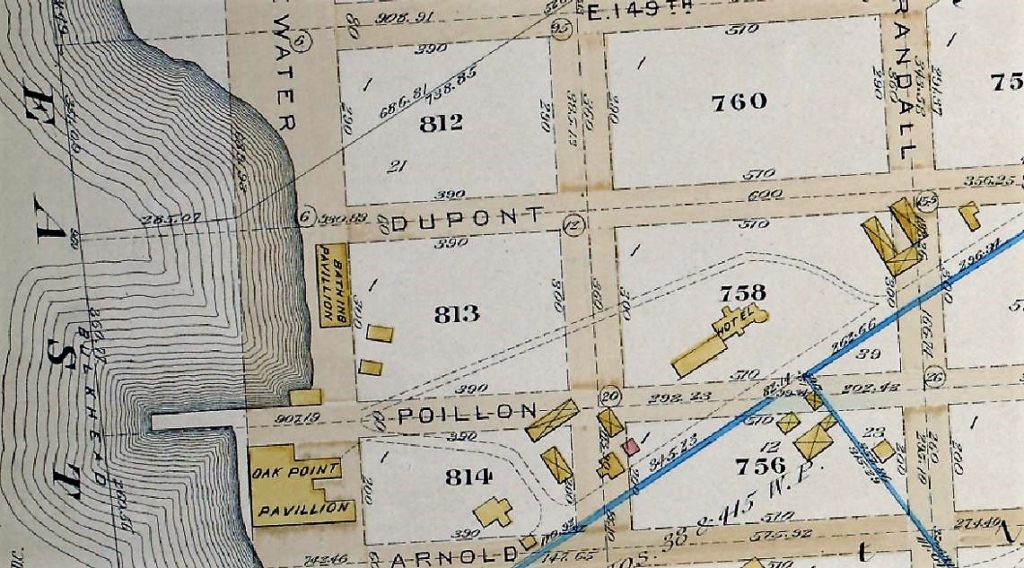
The Oak Point Pavilion and bathing pavilion are depicted on this 1887 map. Oak Point was a favorite family pleasure resort from the late 1880s to 1905. Today, this is the site of several large distribution centers and the Oak Point Yard freight railroad yard currently owned by CSX Transportation.
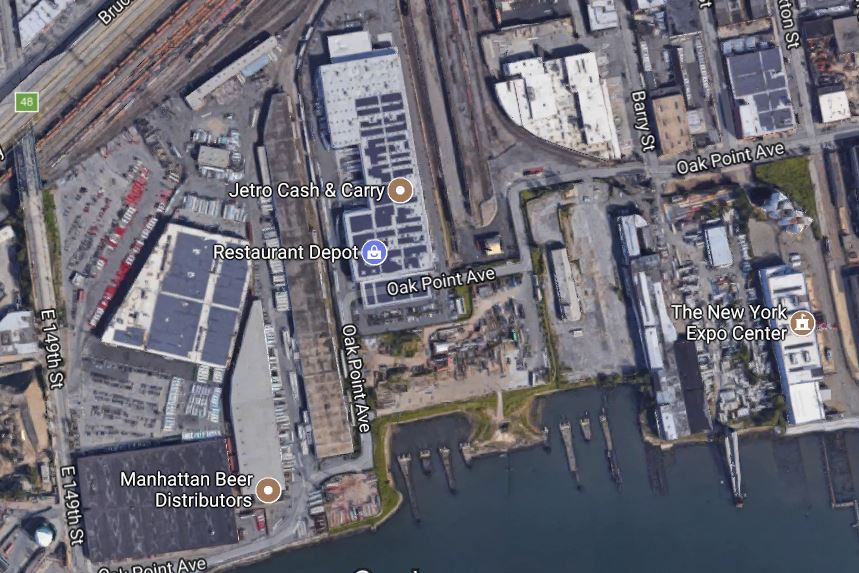
Here’s an aerial view of Oak Point today. The site of Jim Pilkington’s beer garden and Charles Sulzer’s Oak Point Pleasure Grounds near 149th Street is now occupied by Manhattan Beer Distributors and Restaurant Depot. The Oak Point freight yards are also visible at top.
As the men and the goat made their way to Oak Point, Bronco John and his pet bear, Uno, were at The Golden Oar, a saloon at 2376 Third Avenue (near 129th Street) owned by oarsman and notorious gambler Percy Nagle and renowned oarsman Jim Pilkington, who also owned the beer garden at Oak Point. The bear reportedly had a sip of sarsaparilla at the bar, and then jumped on a stage, where he stood next to Jim’s friends Captain Paul Boyton and oarsman George Lee.

Rowing partners Percy Nagle and Jim Pilkington owned the Golden Oar saloon at 2376 Third Avenue in Harlem (at that time, the building was a long, narrow frame structure). Professional scullers Robert Wallace and George W. Lee took over the business in May 1887, and renamed it The Ship. The men had to abandon ship after only a few months when the business failed to make money. This photo taken in 1932 shows 2376 Third Avenue in 1932 (building on right). Museum of the City of New York Collections
Following their stop at the saloon, Bronco John and Uno headed to Oak Point (I have no idea how they got around), where Uno immediately jumped into the river. He walloped about in the water for a while and then he galloped up and down the beach. At one point he seized a man by the trousers. The terrified bystander was rescued before too much damage was done.
For more than a half hour, the bear roamed about unsupervised while Bronco John showed off some tricks with his revolver. The poor goat was then set free, and it immediately scattered away. John lassoed the goat and dragged him up toward the field as the bear followed in hot pursuit.
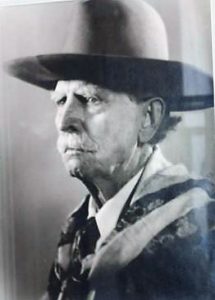
Bronco John in his later years.
“Turn ‘im loose!” the crowd yelled as John released the lasso. The goat ran toward the field again, with the bear right behind him. At one point it looked as if the bear were going to win the race, but the goat picked up speed and Uno eventually lost interest. Bronco John finally got control of the bear and brought him indoors. He then fell asleep telling the crowd frontier life stories.
I have no idea what happened to the goat, the bear, or the man with the torn trousers.
A Brief History of Oak Point
The documented history of Oak Point goes back to April 25, 1666, which is the date that Richard Nicolls, the first English governor of the Province of New York, confirmed the West Farms patent to Edward Jessup and John Richardson. West Farms then comprised the far western section of the town of Westchester (it wasn’t separated from Westchester until 1846).
John Richardson had a daughter, Elizabeth, who was married to Gabriel Leggett, a distinguished Englishman who had arrived in America in 1661. By the right of his wife, Gabriel took ownership of a large portion of the West Farms patent that was then known as the Great Planting Neck. A part of this land was known as Jeafferds Neck.
In his will dated April 16, 1697, Gabriel Leggett bequeathed to his wife and son John his house, orchards, outhouses, land, and meadows in the Planting Neck. Over the next 130 years, the land passed through many hands, eventually making its way back to the Leggetts in 1830, when William Henry Leggett purchased the land from the Austin Graham estate and turned the property into his country seat, which he called Rose Bank.
William H. Leggett moved into the old Graham mansion, which had been built on the former site of the Leggett farm. The view from the front of the home included Riker’s Island, the Two Brothers (North Brother and South Brother Island), the entrance to Hell’s Gate on the East River, and the distant shores of Manhattan.

The view of the East River from the area of Hunts Point in 1864.
In the 1850s, Benjamin Whitlock, a wealthy New York grocer and cotton investor, purchased the Leggett property from Thomas B. Leggett and completely rebuilt the old Graham/Leggett mansion using stone imported from Caen, France. The 100-room mansion featured chandelier-filled hallways, subterranean vaults and cellars for the storage of wine and ammunition, three wells for providing the house with running water, and a drawbridge with a hidden spring that would cause the gates to fly open whenever a horse stepped on the spring.

The Benjamin Whitlock Mansion on the old Leggett farm in Oak Point around 1905, just before the building was razed. The mansion was located just south of Leggett Avenue between present-day Barry and Dupont Streets. The mansion was razed in 1906 to make way for the Rock Plaster Company, which burned down in 1913.
With the end of the Civil War and slavery, cotton ceased to be profitable and Whitlock was forced to abandon his mansion. As nature took over and the weeds moved into, the dilapidated old house became known as “Whitlock’s Folly.”
Following Whitlock’s death, his widow transferred the deed in 1867 to Innocencio Casanova, a Cuban patriot fighting for Cuban independence. The house became a rendezvous for supporters of the Cuba Libra, and the great cellars became storehouses for powder, rifles, and other munitions of war that were smuggled on vessels that accessed the house via the many nearby creeks.
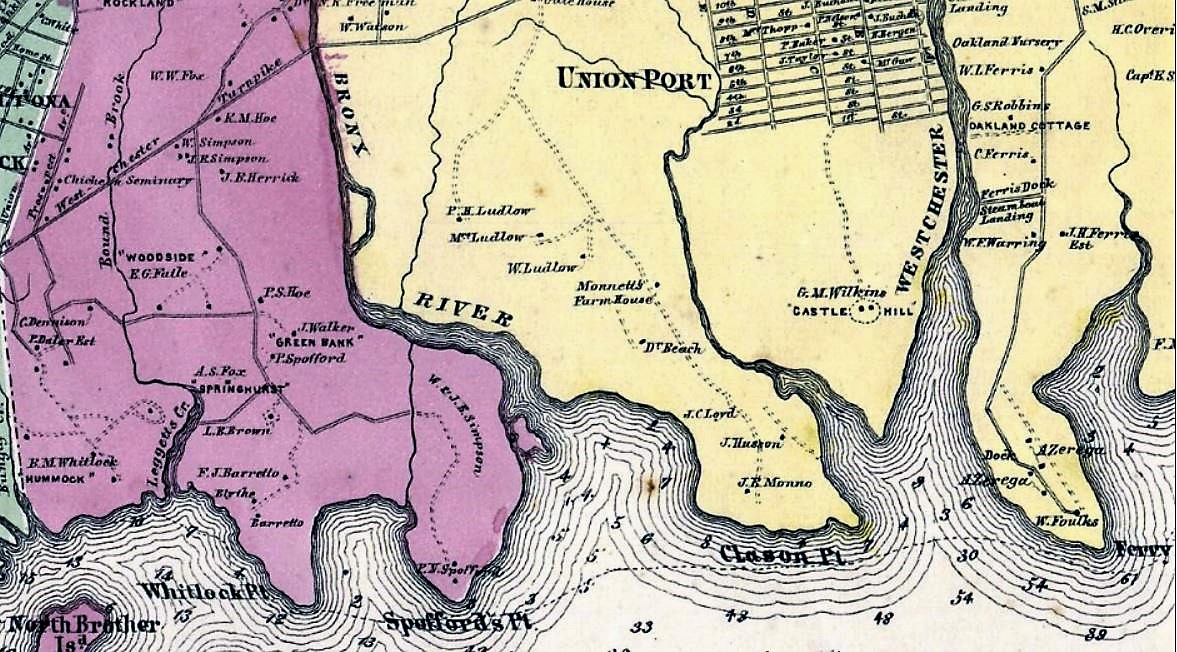
On this 1867 map, Oak Point was still called Whitlock Point (purple section) in honor of Benjamin Whitlock, even though he had passed away.
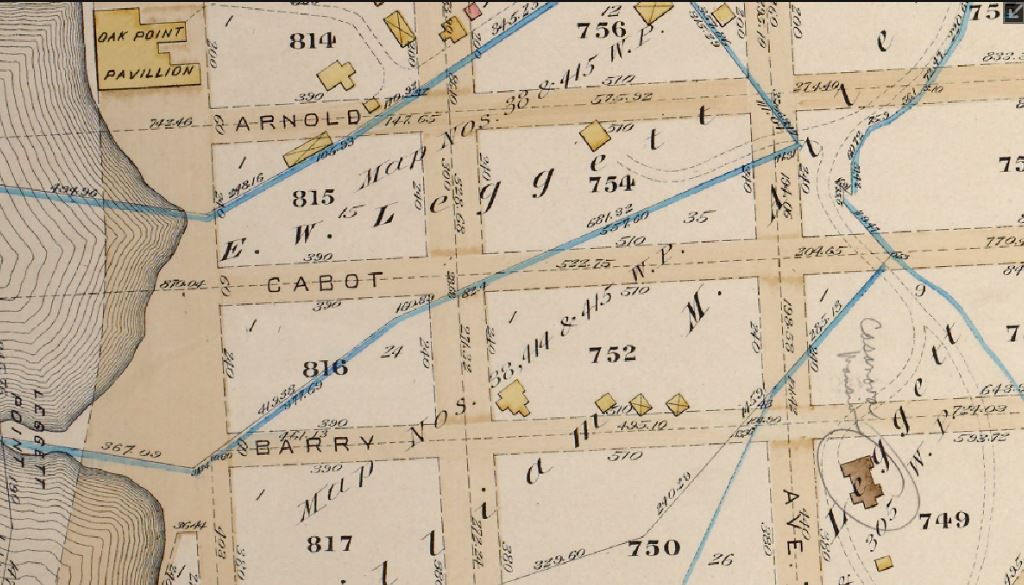
The old Whitlock/Casanova mansion is noted on the bottom right of this 1887 map. The Oak Point Pavilion is at the top left.
On October 2, 1885, the property was acquired by Mr. Robert Augustus Chesebrough, an American chemist who discovered petroleum jelly (which he marketed as Vaseline for the Chesebrough Manufacturing Company). Four years later, during a push by New York Mayor Hugh J. Grant to hold the next World’s Fair in New York to honor the 400th anniversary of the discovery of America by Christopher Columbus, Cheseborough suggested that his land could be a great location for the fair.
Convinced that Oak Point would be the site of the World’s Fair, several prominent English financiers established the East Bay Land and Improvement Company to purchase several hundred acres of land, including Oak Point, Hunts Point, Barretto Point, and other lands in the vicinity. When the 1893 World’s Fair went to Chicago, the men were stuck with the land.
Their first move was to sell to a large part of their holdings to New York, New Haven, and Hartford Railroad for the establishment of the Oak Point freight yard. Church E. Gates & Co. acquired a large tract for its lumber yards, and a syndicate that included Mayor Grant and C.K.G. Billings took over about 125 acres for building the Bronx Terminal. In 1922, the last of the remaining 995 lots between Hunts Point Avenue and the East River were auctioned off for development.
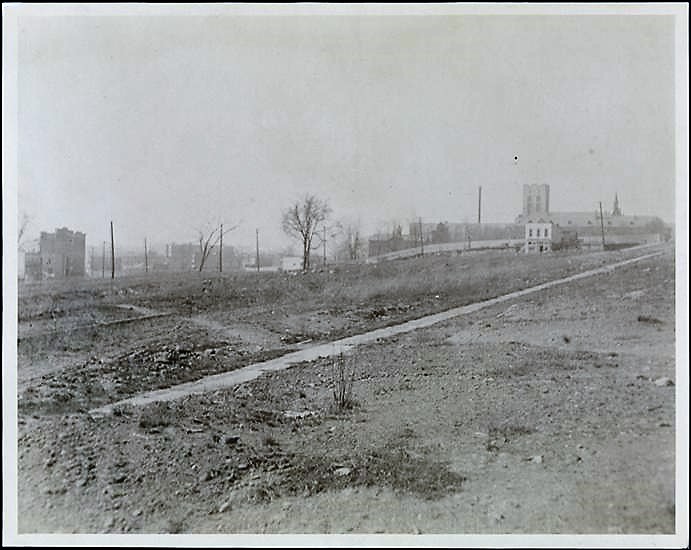
Here’s the intersection of Oak Point Avenue and Barretto Street in 1910, just before developers took over. Museum of the City of New York Collections
The Oak Point Pleasure Grounds
The earliest record of the Oak Point Pleasure Grounds is a newspaper article from 1884, when a “grand complimentary picnic” for the New York City Police Department took place on the grounds, then under the management of rowing partners Percy Nagle and Jim Pilkington from the Golden Oar Saloon. (Big Jim Pilkington was a former member of New York’s Metropolitan Police Force). The event featured swimming, sculling, glass-ball shooting, shot putting, dancing, and beer drinking.
In 1885, Frederick Schermann received permission to construct a merry-go-round on the property. An advertisement in The Sun in 1887 described Charles Sulzer’s Oak Point Pleasure Grounds as a family resort with shady groves, beautiful lawns, boating and bathing facilities. The park was accessible by boat, which left the docks at Harlem Bridge every half hour, or by train and stage coach.
Sometime around 1906, the year the old Leggett/Whitlock mansion was razed, the Oak Point Pleasure Grounds ceased to exist. Over the past 100 years, the land has been used as a landfill during the Bronx’s burning years (1970s), a hangout for criminals, and as an illegal dumping ground with reported ties to the Maffia.
In 2002, Steven Smith, an engineer who grew up in Greenwood Lake, New York (where, by the way, Pilkington once participated in a sculling race), purchased 28 acres on Oak Point. It took him seven years to clean up the trash dumped by Britestarr, which had alleged ties to John A. Gotti (Smith told The New York Times he didn’t find any bodies, but he did find five handguns).
Smith worked out a deal with the State Department of Environmental Conservation to build wetlands on three acres of the property, which serve as a haven for birds from the nearby islands. Although much of the wetlands were destroyed by Hurricane Sandy in 2012, there is hope for the land: In 2013, a harbor seal that Smith named Oakie started making an appearance at Oak Point.
It’s a good thing there are no bears or goats.

Here’s an aerial view of Oak Point as it looks today. It’s hard to imagine, but 130 years ago, a bear named Uno chased after a Harlem goat on this very site.




I hear there is still one OLD GOAT still hanging out these.